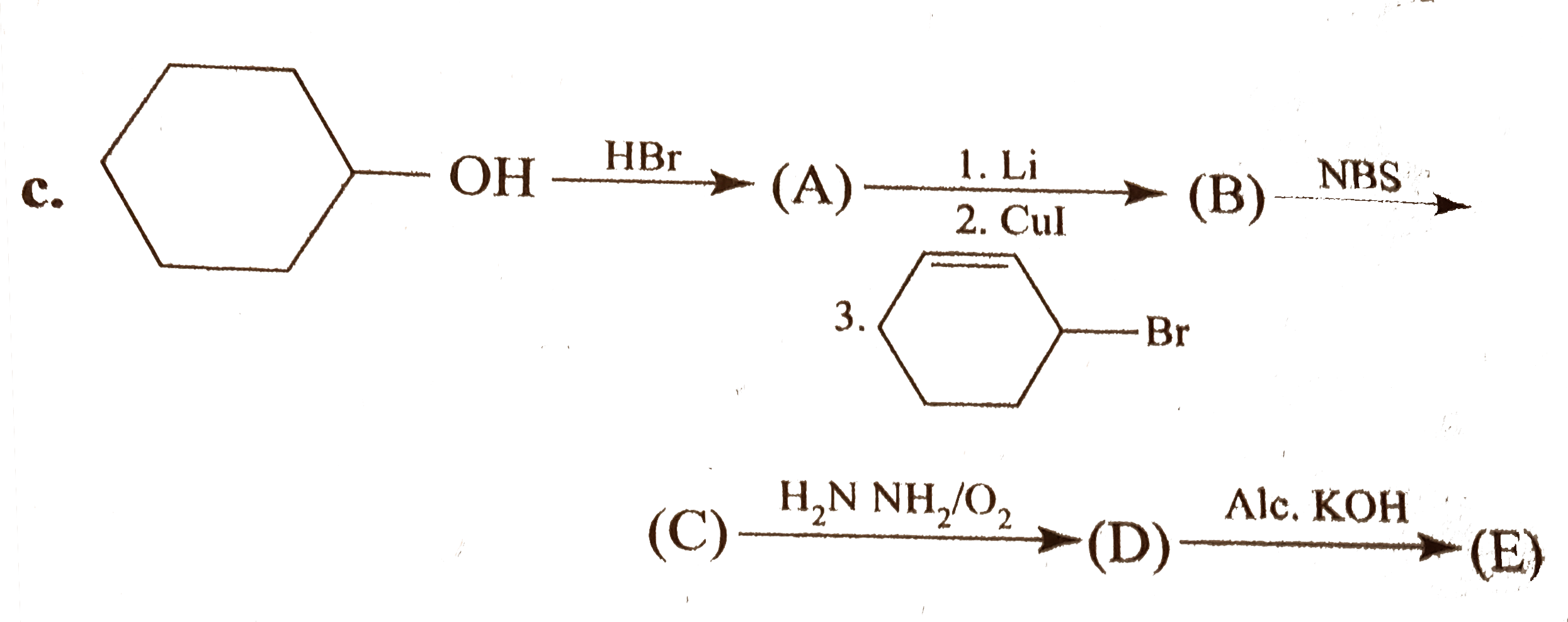A and B are geometrical isomers (R-CH-R)of which type?
A is cis and B is trans
A is trans and B is cis
A and B are cis
A and B are trans
To solve the problem, we need to analyze the reactions involving the given compound with the reagents Na/NH₃ and Lindlar's catalyst. Let's break it down step by step:
Step 1: Identify the Starting Compound
The starting compound is represented as R-C≡C-R, which indicates a terminal alkyne with two R groups attached to the carbon atoms of the triple bond.
Step 2: Reaction with Na/NH₃
When the alkyne (R-C≡C-R) reacts with sodium in liquid ammonia (Na/NH₃), it undergoes a reduction to form a cis-alkene. The reaction can be summarized as follows:
- The triple bond is converted to a double bond, resulting in the formation of an alkene.
- The product formed will have the R groups and hydrogen atoms in a trans configuration relative to each other.
Product A: The product formed from this reaction is R-CH=CH-R (trans configuration).
Step 3: Reaction with Lindlar's Catalyst
Next, when the same alkyne (R-C≡C-R) is treated with Lindlar's catalyst (which is a poisoned palladium catalyst), it also reduces the triple bond to a double bond but in a different manner:
- The product formed will have the R groups and hydrogen atoms in a cis configuration relative to each other.
Product B: The product formed from this reaction is R-CH=CH-R (cis configuration).
Step 4: Determine the Geometrical Isomers
From the reactions:
- Product A (from Na/NH₃) is in the trans configuration.
- Product B (from Lindlar's catalyst) is in the cis configuration.
Conclusion
Thus, the geometrical isomers A and B are:
- A is trans (R-CH=CH-R)
- B is cis (R-CH=CH-R)
The final answer is:
- A is trans and B is cis.
The starting compound is represented as R-C≡C-R, which indicates a terminal alkyne with two R groups attached to the carbon atoms of the triple bond.
When the alkyne (R-C≡C-R) reacts with sodium in liquid ammonia (Na/NH₃), it undergoes a reduction to form a cis-alkene. The reaction can be summarized as follows:
- The triple bond is converted to a double bond, resulting in the formation of an alkene.
- The product formed will have the R groups and hydrogen atoms in a trans configuration relative to each other.
Next, when the same alkyne (R-C≡C-R) is treated with Lindlar's catalyst (which is a poisoned palladium catalyst), it also reduces the triple bond to a double bond but in a different manner:
- The product formed will have the R groups and hydrogen atoms in a cis configuration relative to each other.
From the reactions:
- Product A (from Na/NH₃) is in the trans configuration.
- Product B (from Lindlar's catalyst) is in the cis configuration.
Thus, the geometrical isomers A and B are:
- A is trans (R-CH=CH-R)
- B is cis (R-CH=CH-R)
- A is trans and B is cis.
Topper's Solved these Questions
- HYDROCARBONSBOOK - VMC MODULES ENGLISHCHAPTER - HYDROCARBONSEXERCISE - Level-2
50 Videos
- HYDROCARBONSBOOK - VMC MODULES ENGLISHCHAPTER - HYDROCARBONSEXERCISE - Level-2 (Numerical Value Type)
15 Videos
- HYDROCARBONSBOOK - VMC MODULES ENGLISHCHAPTER - HYDROCARBONSEXERCISE - Level-0 Long Answer Type (5 Marks)
1 Videos
- HALOALKANES AND HALOARENESBOOK - VMC MODULES ENGLISHCHAPTER - HALOALKANES AND HALOARENESEXERCISE - IN-CHAPTER EXERCISE - F
6 Videos
- ICONIC EQUILIBRIUMBOOK - VMC MODULES ENGLISHCHAPTER - ICONIC EQUILIBRIUMEXERCISE - IMPECCABLE
50 Videos
Similar Questions
Knowledge Check
BLindar's−−−−→CatalystR−C≡C−RNa/NH3−−−−−→4
A and B are geometrical isomers (R−CH=CH−R) of which type ?AA is trans, B is cisBA and B both are cisCA and B both are transDA is cis, B is transCH3CH2CH2−O∣∣C−H+CH3−C≡ChNa,NH3(l)−−−−−−−→
A B
B C
C D
D
CH3−CH=C∣Br−C∣Cl−CH−CH3
How many geometrical isomers are possible for this compound?A2B3C4D6
Complete the following reactions :
a. (F)+D←−−(E)1.Li←−−−2.Cul(D)HBr←−−CH3CH=CH2NBS−−→(A)NBr−−−−→RCOOR(B)Mg−−→(C)
b. CH3CH=CH−CH32NBS−−−→(A)2Ic−−−→(B)H2NNH2/O2−−−−−−−−→(C)
c.
View SolutionR−≡(A)−≡−RLindlar's catalyst+H2−−−−−−−−−−−−→(B)

Compounds (B) and (C) are:
View SolutionCH3−C≡CHLinddar's−−−−→catalyst(A)ConcH2SO4−−−−−−→H2O(B)
What are the products (A) and (B) in the given reaction?
View SolutionR−O∣∣C−RHCN⇐====⇒(catalyst)R−OH∣C∣CN−R
Which of following can be used as a catalyst in the above reaction?
View SolutionBr−(CH2)12−C≡CHNaNH2−−−−→(A)Lindlar−−−−→Catalyst(B), Product (B) is
View Solution
